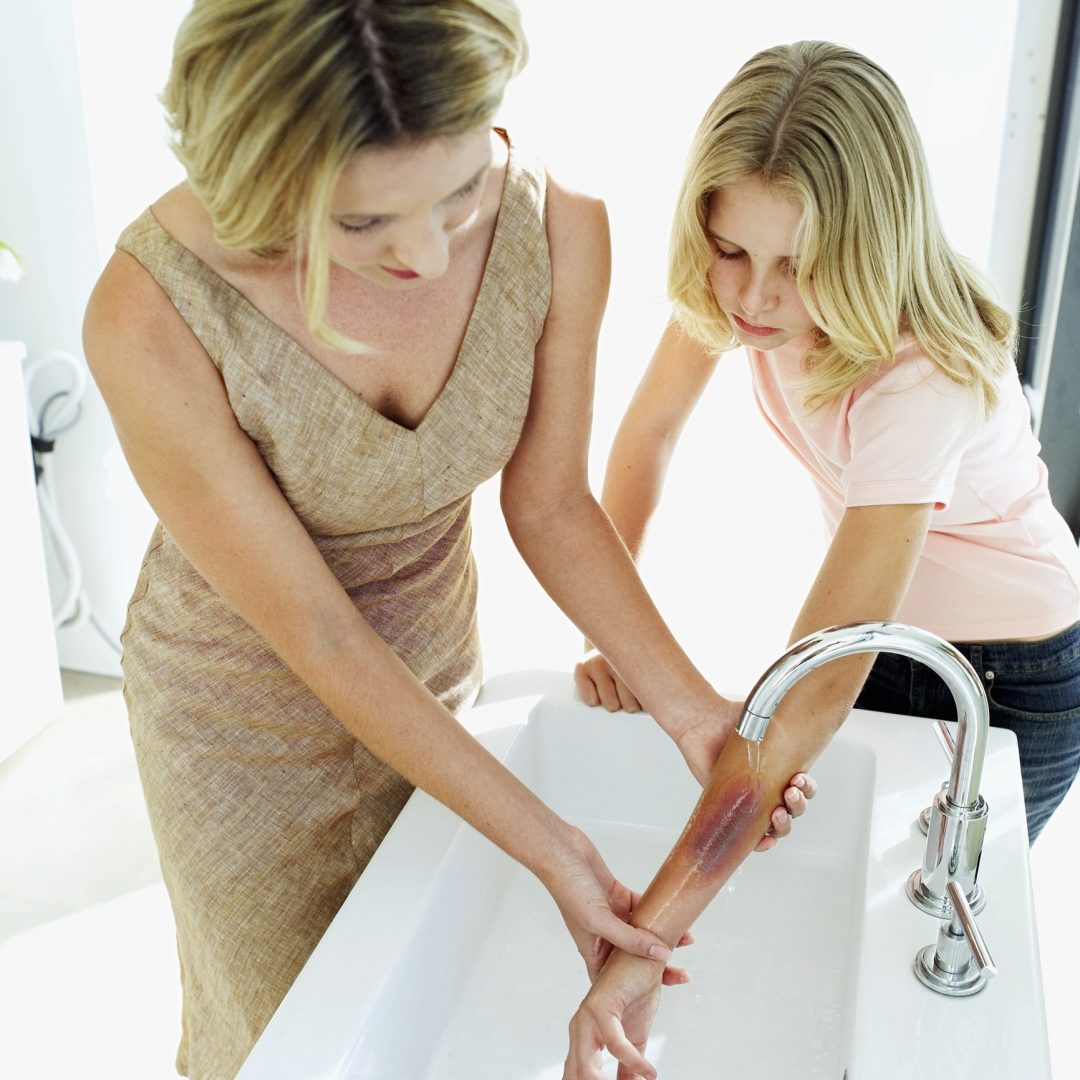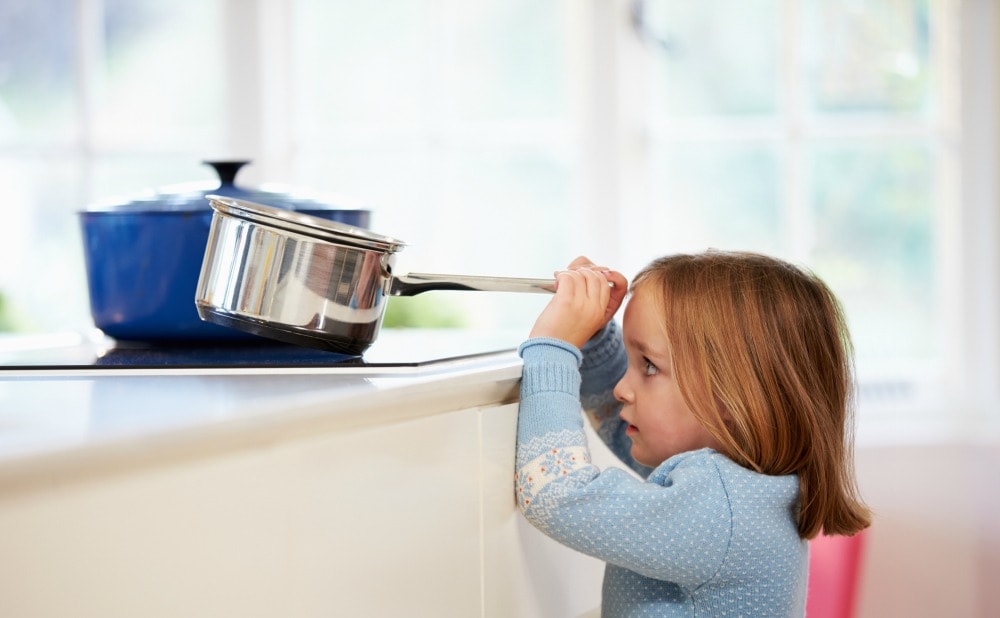As a parent, you may often fear for your child’s health and safety.
Fortunately, with a bit of preparation and first aid know-how, you can feel more confident in your child’s well-being.
Today, we’ll cover 6 first aid tips that’ll help you prepare for both minor injuries and medical emergencies.
Childproof Your Home
The average household is full of objects and substances that could potentially be harmful to a child.
In fact, there are roughly 246,000 hospitalizations due to child injuries in the home, every year.
That’s why it’s important to keep dangerous items out of your child’s reach.
Here are some childproofing tasks you’ll want to complete:
- Lock up all weapons and sharp objects.
- Make sure any small appliances can’t be pulled off a countertop by your child.
- Install safety locks on all of the cabinets and drawers in your home.
- Always use the back burners on the stove to help combat accidental burns.
- Keep all medicines and cleaners locked away.
- Install locks on all toilets to ensure that the lid stays closed.
- Unplug all hair dryers and similar items immediately after using them.
- Cover all of your outlets with outlet protectors.
- Install safety gates to block off any dangerous areas, like staircases.
- Use corner bumpers on the corners of your furniture.
- Secure all furniture to prevent it from being knocked over.
Childproofing steps vary based on home features, the child’s age, etc. – so make sure you research to determine exactly what you must do.
By following basic childproofing steps, you should be able to prevent common child injury causes.
Handle Minor Cuts and Scrapes Correctly
Chances are, if you have a child, you’re going to need to treat a minor cut or scrape at some point.

Let’s go over the steps to ensure you can handle these minor injuries confidently.
- Start by washing your hands thoroughly.
- If your child is bleeding, apply pressure to the wound with a towel or a clean bandage until it stops bleeding. You’ll also want to elevate the wound, if possible.
- When the bleeding stops, examine the wound. If you see any foreign objects, try to flush them out with water. You may need to use a pair of tweezers to remove a stubborn foreign object.
- Wash your child’s wound with warm water and soap, and pat it dry.
- Once the wound is dry, cover it with a sterile bandage. If you’d like, you can also apply an antibiotic ointment to your child’s wound before you dress it.
By doing so, you can speed the healing process and help ensure that the wound doesn’t become infected.
- If your child is a baby or toddler, make sure they are unable remove the bandage and put it in their mouth, as this can put them at risk for choking.
Keep in mind that you’ll need to visit the emergency room if the wound still bleeds after you’ve applied pressure for 10 minutes.
Avoid removing any foreign object that is large or deeply embedded in your child’s skin – that task is best left to a medical professional.
Act Quickly When Your Child Is Choking
According to the NY Department of Health, choking is the fourth leading cause of unintentional death in children under the age of 5.
If you see that your child is choking, you’ll need to act fast to remedy the situation.
If your child is over one year of age, you can perform the Heimlich Maneuver to dislodge the object block their airway.
Ideally, you want to perform the Heimlich on a person who is standing up. So, if at all possible, get your child to stand.
Once they’re standing, you should stand behind them and wrap your arms around their abdomen.
Make sure you’re in a stable position where you can catch your child if they fall backward for any reason.
Then, make a fist with your dominant hand.
Put your fist right above your child’s belly button (and under the breast bone).
Wrap your other hand around your fist.
Pull inward and up, forming a “J” shape with each thrust.
Use a good amount of force when you perform this action, but don’t overdo it – especially if you are performing the Heimlich on a smaller child.
You’ll want to perform these inward and upward thrusts in quick succession.
Stop immediately if your child becomes unconscious.
Once the object is dislodged, make sure our child is able to breathe normally. You’ll need to call for emergency medical help right away if you cannot dislodge the object.
Treat First-Degree and Small Second-Degree Burns Properly
Anything from hot water to a stove burner could result in a minor burn on your child. Fortunately, most minor burns are fairly easy to treat.

Start by removing any clothing covering the burn.
Then, run cool water over the affected area for several minutes to help alleviate the pain.
You may also want to put a cool, wet cloth on the burn to help.
After that, carefully pat the area dry. Cover it loosely with gauze or a sterile non-stick bandage.
Once you’re done, give your child a pain reliever.
Acetaminophen and ibuprofen can both be good options, but make sure your child is old enough to take whatever medicine you want to administer before you give it to them.
Watch for signs of infection, and follow up with your doctor to let them know about the burn.
They may recommend an ointment to help with the healing process.
Learn CPR
Cardiopulmonary Resuscitation (or CPR) is a lifesaving measure designed to keep blood and oxygen circulating to the brain and other organs, which can help prevent brain damage or even death.
But according to the American Heart Association, 70% of Americans don’t know how to administer CPR in the event of an emergency.
There are several reasons to learn CPR, including the ability to help your child in the event they are unresponsive or not breathing.
Keep in mind, the way you perform CPR can depend on your child’s age, so be sure you check on the appropriate actions for your child.
There are countless resources online with instructions on how to perform CPR, however, proper training is always recommended.
If you’re a Maryland resident, Chesapeake AED Services offers flexible and highly informative CPR Certification Training Classes that could help you save a life.
Keep a List of Emergency Phone Numbers Somewhere Easily Accessible In Your Home
Include numbers for poison control, your pediatrician, and anyone else you may need if an emergency situation arises.
You’ll also want to take a copy of your emergency list when you leave the house.
Consider keeping it in your purse/wallet, or storing the list of numbers on your cell phone.
And remember, don’t hesitate to call for help when your child needs it.
Here are some examples of when you should call emergency services:
- Your child becomes unconscious.
- Your child is experiencing significant, uncontrolled bleeding.
- You think your child has been poisoned.
- Your child is having a seizure.
- Your child is having serious breathing problems and/or turning blue.
- Your child is not responding normally.
- Your child is experiencing persistent vomiting.
These may not be the only situations that require emergency help for your child.
Use your best judgment, and remember – better safe than sorry.
Conclusion
Still feeling unsure about your first aid skills when it comes to your child?
If so, contact Chesapeake AED Services and enrolling in a Maryland First Aid and CPR certification class today!
Although more than 3.4 million children experience an unintentional household injury every year, proper CPR and First Aid Training could help keep your family safe.
The valuable information and skills you’ll learn from our certified trainers could help you save your child’s life, or at the very least, save them from an avoidable injury.

